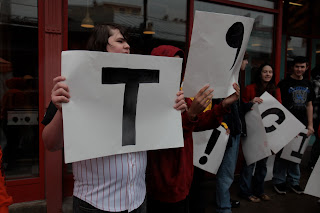The final performance for "the market" is almost here! As we work together to deepen our performance vocabulary, the students have been thinking about issues in Cincinnati that are important to them. Here's a list that came out of one of those conversations:
IN CINCINNATI, WHAT BRINGS US TOGETHER OR KEEPS US APART?
*food and parties- social divides*
*lack of warmth- touch and eye contact*
*social cultural events bring people together*
-community restaurants- food - food culture as something that can unify communities, help to connect across communities and also demonstrate separations/segregation
-race
-prevalence of stereotypes
-afraid of being rejected, afraid of change
-people choose to be separate in their neighborhoods, they like what is familiar, prefer to stay in comfort zones
-"high school city" great loyalty and connection to high schools, but sometimes high schools bring people together across neighborhoods
-people don't understand folks from other walks of life
-prejudices
-class differences and backgrounds
-people come together around music, sports, ice and roller-skating, movies, kings island, churches, mall
-making personal relationships challenges these things that keep people apart and can bring people together
-money and access- segregation, poor transportation system
-violence: wanting power and respect: intense segregation leaves people feeling isolated, take out aggression in neighborhoods
-"anybody and everybody can do something": volubility of violence
-people can come together around tragedy ie riots (within certain communities), windstorms
-divide in schooling
******
Here's a note from Kira, the theater artist working with the students, about these conversations:
"The Clark students developed lists of how and why people are separated in Cincinnati, mostly by racial, economic and geographic factors. The next questions to discuss, from my point of view, are, why and how do these separations become dangerous to society and our individual and collective well-being? How do these separations connect to the other issues the kids are talking about? I'm thinking especially about violence within communities and the fact that many kids bring up a culture of fear and living in a city where they feel people on the streets don't want to recognize or reach out to each other, which is reinforced by a city that is divided. I think it is important to think and talk about access and power: culturally, people may enjoy different kinds of music or food or ways of relaxing, but the real question is what are the essentials that all residents of a city should have access to? Here is where we get back to the question of "What is the Cincinnati of your dreams?"
I think the next step in our work is to really examine all these issues the students have brought up and to explore the purposes of the performances. Given their observations, interpretations and analysis, what is their vision for how they'd like Cincinnati to be? Can these performances TRANSFORM, EDUCATE, ENTERTAIN? How can the work we do at Findlay Market challenge what the students have identified as problems in the city?"
See you all on Saturday!















